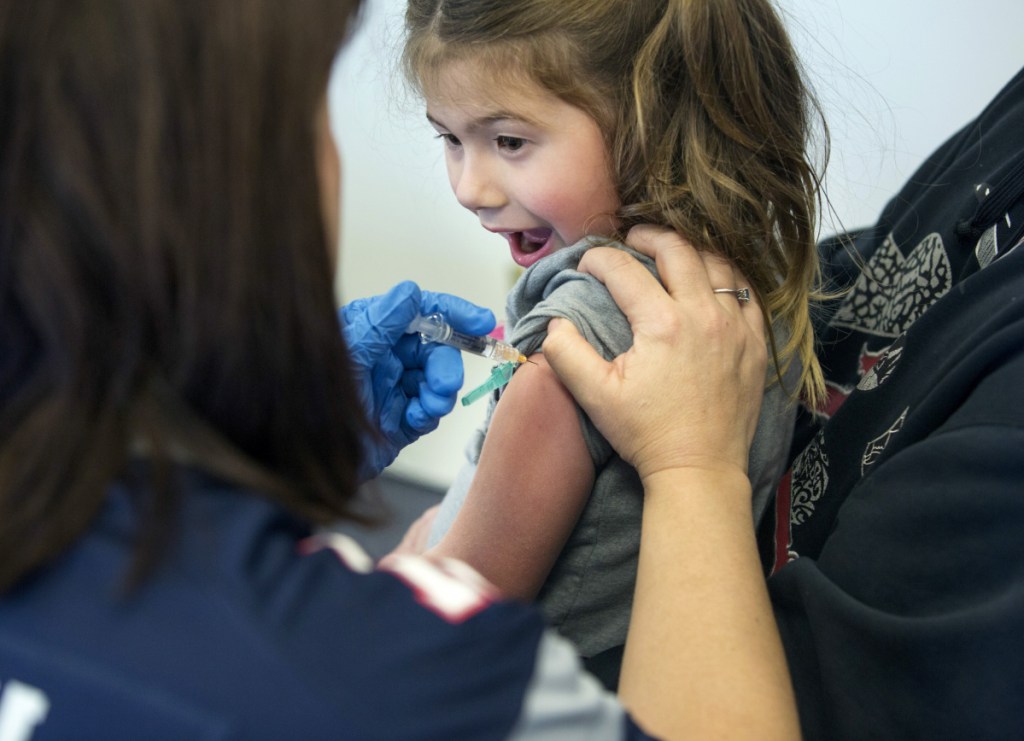Influenza cases declined slightly last week, but the flu is still rampant in Maine, straining hospital emergency departments, keeping people from work and school and causing 43 flu-related deaths so far this season.
The Maine Center for Disease Control and Prevention on Wednesday reported 831 new cases for the week ending Feb. 10, down from 876 new cases the previous week, but still the second-highest week of the 2017-18 flu season, which runs from October through May.
“I’m cautiously optimistic we’ve hit the peak and cases could start going down, but I’m not convinced yet,” said Sara Robinson, a Maine state epidemiologist. “There’s still a lot of flu out there. Stay home if you’re sick.”
Flu is notoriously unpredictable, and three weeks ago cases appeared to have plateaued at about 500 per week, but new cases jumped to 876 the week of Feb. 3.
The total number of reported flu cases for the season is now 4,147, and unless cases decline substantially, Maine could top the 2016-17 season total of 5,830 confirmed cases. The actual number of flu cases is much higher because many people recover at home and are not tested for influenza.
Symptoms include fever, chills, muscle aches, swollen lymph nodes, sore throat, headaches, fatigue and coughing. Aside from immunization, basic hygiene such as frequent hand washing, getting plenty of sleep and staying away from sick people helps prevent the flu.
Flu is prevalent across the United States and was still increasing in the week of Feb. 3, the latest nationwide data available, according to the U.S. Centers for Disease Control and Prevention. There were 124,316 reported flu cases nationwide.
Dr. Anne Schuchat, acting director of the federal CDC, told reporters in a conference call on Feb. 9 that this year’s flu season is “particularly challenging” and may rival the H1N1 epidemic in 2009.
“We may be on track to break some recent records,” Schuchat said.
Maine’s more populated counties have been hit hardest. York County has reported 955 cases, followed by Cumberland County with 629 and Penobscot County at 580.
This year’s predominant strain of influenza A, H3N2, is a virulent strain that’s resulting in more hospitalizations and deaths, according to the federal CDC. In Maine, 20 percent of all reported flu cases in 2017-18 have resulted in hospitalization, compared to 14 percent last season.
There have been 43 flu-related deaths so far this flu season, but no pediatric deaths, and 842 hospitalizations. There were 71 flue-related deaths in the 2016-17 season.
Dr. Kolawole Bankole, director of Portland’s Public Health Division, said it’s “too soon to call” whether flu cases have peaked.
“The influenza season is still raging,” Bankole said. “It’s not letting up yet.”
Bankole said the city has taken a number of steps this year to try to lessen the impact of the flu, including February flu clinics, putting hand sanitizers in all city buildings, hanging posters in all city bathrooms advising how to prevent the flu and recommending a quarantine for homeless people staying at the city’s shelter while they are recovering from the flu.
While H3N2 is the predominant strain, influenza B is starting to show up more, accounting for about 10 percent of all tests in Maine and 20 percent nationwide. For most of the flu season, H3N2 had accounted for about 95 percent of all influenza cases in Maine and about 90 percent nationwide. Influenza B is typically a less severe strain and not as likely to require hospitalization.
The flu shot’s effectiveness for this season has still not been determined, but for those who get a flu shot and still contract influenza, symptoms tend to be milder and not last as long, research has shown. The vaccine is never 100 percent effective because the flu virus is always mutating. In order to get the vaccine on the market in time, scientists must predict months in advance the predominant strains of flu that will be circulating. The vaccine was 48 percent effective in 2016-17 and 59 percent effective in 2015-16, according to the federal CDC.
Joe Lawlor can be contacted at 791-6376 or at:
jlawlor@pressherald.com
Twitter: joelawlorph
Send questions/comments to the editors.




Comments are no longer available on this story